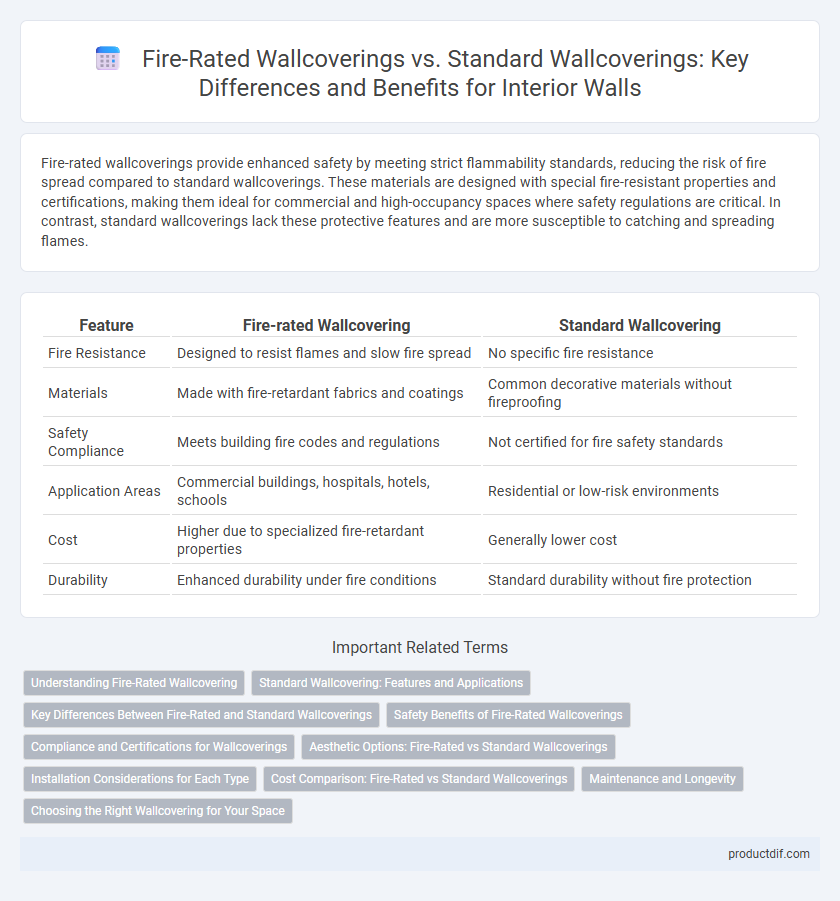Fire-rated wallcoverings provide enhanced safety by meeting strict flammability standards, reducing the risk of fire spread compared to standard wallcoverings. These materials are designed with special fire-resistant properties and certifications, making them ideal for commercial and high-occupancy spaces where safety regulations are critical. In contrast, standard wallcoverings lack these protective features and are more susceptible to catching and spreading flames.
Table of Comparison
| Feature | Fire-rated Wallcovering | Standard Wallcovering |
|---|---|---|
| Fire Resistance | Designed to resist flames and slow fire spread | No specific fire resistance |
| Materials | Made with fire-retardant fabrics and coatings | Common decorative materials without fireproofing |
| Safety Compliance | Meets building fire codes and regulations | Not certified for fire safety standards |
| Application Areas | Commercial buildings, hospitals, hotels, schools | Residential or low-risk environments |
| Cost | Higher due to specialized fire-retardant properties | Generally lower cost |
| Durability | Enhanced durability under fire conditions | Standard durability without fire protection |
Understanding Fire-Rated Wallcovering
Fire-rated wallcoverings are specifically designed to resist ignition and slow the spread of flames, providing crucial safety benefits in commercial and residential buildings. These wallcoverings meet stringent fire safety standards such as ASTM E84 or NFPA 286, ensuring enhanced protection compared to standard wallcoverings that lack these certifications. Using fire-rated materials helps in complying with building codes and reduces the risk of fire damage and occupant injury.
Standard Wallcovering: Features and Applications
Standard wallcoverings offer diverse styles, textures, and materials ideal for enhancing aesthetic appeal in residential and commercial interiors without specialized fire-resistant properties. These wall coverings typically emphasize design flexibility, cost-efficiency, and ease of installation, making them suitable for low-risk environments where fire safety codes are less stringent. Applications include living rooms, offices, retail spaces, and feature walls where decorative impact is prioritized over fire protection.
Key Differences Between Fire-Rated and Standard Wallcoverings
Fire-rated wallcoverings are engineered to resist ignition and retard fire spread, making them essential for safety in commercial buildings and public spaces, while standard wallcoverings prioritize aesthetics and durability without specific fire-resistant properties. These fire-rated options undergo rigorous testing to comply with fire safety codes such as ASTM E84 or NFPA 701, ensuring they minimize smoke generation and flame spread. In contrast, standard wallcoverings lack these certifications and may contribute to faster fire propagation, posing greater risks in emergency scenarios.
Safety Benefits of Fire-Rated Wallcoverings
Fire-rated wallcoverings provide enhanced safety by resisting ignition and limiting flame spread, crucial for reducing fire hazards in commercial and residential buildings. Unlike standard wallcoverings, fire-rated options meet strict regulatory standards such as ASTM E84 and NFPA 286, ensuring compliance with building codes and insurance requirements. Their use significantly increases occupant protection and property preservation during fire emergencies.
Compliance and Certifications for Wallcoverings
Fire-rated wallcoverings comply with stringent fire safety standards such as ASTM E84 and NFPA 701, ensuring reduced flame spread and smoke development. Standard wallcoverings typically lack these certifications, making them unsuitable for commercial buildings with strict fire codes. Certified fire-rated products contribute to building compliance, enhancing occupant safety and meeting insurance requirements.
Aesthetic Options: Fire-Rated vs Standard Wallcoverings
Fire-rated wallcoverings provide enhanced safety by meeting stringent flame resistance standards while offering a range of aesthetic options that closely resemble standard wallcoverings. These options include various textures, patterns, and colors designed to maintain design integrity without compromising fire safety compliance. Standard wallcoverings, while more diverse in materials and finishes, lack the specialized fire-retardant properties essential for regulated commercial and institutional environments.
Installation Considerations for Each Type
Fire-rated wallcoverings require specialized adhesives and precise installation techniques to maintain their fire-resistant properties and ensure compliance with building codes. Standard wallcoverings allow for more flexibility in adhesive choice and installation methods but do not offer the same level of safety or regulatory approval in fire-prone environments. Proper substrate preparation and professional application are critical for both types to achieve optimal durability and performance.
Cost Comparison: Fire-Rated vs Standard Wallcoverings
Fire-rated wallcoverings typically cost 20-50% more than standard wallcoverings due to specialized fire-retardant materials and compliance with safety codes such as NFPA and ASTM E84. While standard wallcoverings offer affordability and aesthetic variety, fire-rated options provide essential fire safety benefits valued in commercial and institutional settings. Budget planning for wall coverings should consider long-term safety investments versus initial material costs, balancing regulatory requirements with design preferences.
Maintenance and Longevity
Fire-rated wallcovering offers superior durability and requires less frequent replacement compared to standard wallcoverings, due to its enhanced resistance to heat and flame damage. Maintenance for fire-rated materials typically involves specialized cleaning products that preserve their fire-retardant properties while preventing degradation. Standard wallcoverings often need more regular upkeep and earlier replacement, as they are more susceptible to wear, staining, and fire-related deterioration.
Choosing the Right Wallcovering for Your Space
Fire-rated wallcoverings are designed to meet stringent fire safety standards, providing enhanced protection by slowing the spread of flames and reducing smoke emission, making them ideal for commercial and high-occupancy spaces. Standard wallcoverings offer a wide variety of designs and textures but lack fire resistance, making them more suitable for residential or low-risk areas where aesthetic appeal takes precedence over safety requirements. Selecting the right wallcovering depends on assessing the specific fire safety codes applicable to your space, the level of foot traffic, and the desired balance between safety and design.
Fire-rated Wallcovering vs Standard Wallcovering Infographic

 productdif.com
productdif.com